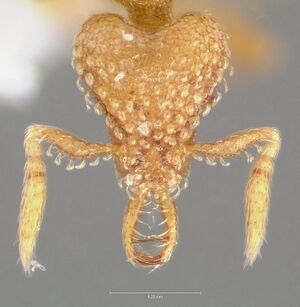Strumigenys levana
| Strumigenys levana | |
|---|---|

| |
| Scientific classification | |
| Kingdom: | Animalia |
| Phylum: | Arthropoda |
| Class: | Insecta |
| Order: | Hymenoptera |
| Family: | Formicidae |
| Subfamily: | Myrmicinae |
| Tribe: | Attini |
| Genus: | Strumigenys |
| Species: | S. levana |
| Binomial name | |
| Strumigenys levana Fisher, 2000 | |
Known from litter-samples from a number of forest habitats.
Identification
Bolton (2000) - A member of the lutron complex in the Strumigenys arnoldi-group. S. levana is distinguished from other species in the arnoldi-group by the presence of 4 antennal segments, distinct longitudinal costulae on the pronotal disc, and absence of a pronotal humeral hair.
Keys including this Species
Distribution
Latitudinal Distribution Pattern
Latitudinal Range: -18.04833° to -18.04833°.
| North Temperate |
North Subtropical |
Tropical | South Subtropical |
South Temperate |
- Source: AntMaps
Distribution based on Regional Taxon Lists
Malagasy Region: Madagascar (type locality).
Distribution based on AntMaps
Distribution based on AntWeb specimens
Check data from AntWeb
Countries Occupied
| Number of countries occupied by this species based on AntWiki Regional Taxon Lists. In general, fewer countries occupied indicates a narrower range, while more countries indicates a more widespread species. |

|
Estimated Abundance
| Relative abundance based on number of AntMaps records per species (this species within the purple bar). Fewer records (to the left) indicates a less abundant/encountered species while more records (to the right) indicates more abundant/encountered species. |

|
Biology
|
Castes
Worker
Images from AntWeb
   
| |
| Holotype of Strumigenys levana. Worker. Specimen code casent0005570. Photographer April Nobile, uploaded by California Academy of Sciences. | Owned by MCZ, Cambridge, MA, USA. |
   
| |
| Worker. Specimen code casent0005571. Photographer April Nobile, uploaded by California Academy of Sciences. | Owned by CAS, San Francisco, CA, USA. |
   
| |
| Worker. Specimen code casent0005572. Photographer April Nobile, uploaded by California Academy of Sciences. | Owned by CAS, San Francisco, CA, USA. |
Nomenclature
The following information is derived from Barry Bolton's Online Catalogue of the Ants of the World.
- levana. Strumigenys levana Fisher, in Bolton, 2000: 632 (w.) MADAGASCAR.
Unless otherwise noted the text for the remainder of this section is reported from the publication that includes the original description.
Description
Worker
Holotype. TL 1.6, HL 0.37, HW 0.36, CI 95, ML 0.16, MI 43, SL 0.22, SI 62, PW 0.20, AL 0.41. Characters of lutron-complex. Mandible blade narrow, linear, outcurved; without intercalary denticles between the apical fork teeth. Right mandible with a short distal preapical tooth and a spiniform proximal preapical tooth located at about the apical third of the length; left mandible only with the spiniform proximal preapical tooth. Preocular lamina broad, projecting below the antennal insertion. Anterior clypeal margin with broad spoon-shaped hairs directed dorsally. Dorsum of head behind clypeus reticulate-punctate and with numerous broadly scale-like to spoon-shaped hairs on anterior two-thirds. Dorsum of head with a transverse row of 4 hairs close to the occipital margin. Upper scrobe margin with a continuous row of scale-like to spoon-shaped hairs; apicoscrobal hair absent. Eye very small, with 3 ommatidia in total and situated just above the ventral scrobe margin. Antenna with 4 segments. Leading edge of scape a dorsoventrally flattened convex lamella with a row of projecting scale-like to spoon-shaped hairs. In profile, the promesonotum slightly convex; propodeal dorsum shallowly convex anteriorly, sloping posteriorly to the declivity. Propodeal teeth very short, mostly incorporated in the lamella, with only a small point projecting. Sides of alitrunk smooth to superficially reticulate-punctate. Pronotal disc with distinct longitudinal costulae and not sculptured as posterior dorsum of head. In between costulae, pronotum smooth or with fine punctulate sculpture; remainder of dorsal alitrunk and at least the upper half of the propodeal declivity reticulate-punctate to alveolate. Pronotal humeral hair absent. Mesonotum with 2 pairs of erect hairs. Ground-pilosity of dorsal alitrunk consisting of scattered small erect hairs. Dorsal surface of petiole node with faint reticulate-punctate sculpture that is almost effaced; the postpetiole glassy smooth. Petiole, postpetiole and gaster with clavate hairs. In profile the petiole with a well developed spongiform lamella. Postpetiole with well developed lateral and ventral spongiform lobes. Base of first gastral tergite with fine costulae radiating on each side of a broad central clear area, remainder of gaster more or less smooth and shiny. Color dull yellow to pale brown.
Paratype. TL 1.6-1.7, HL 0.38-0.39, HW 0.34-0.35, CI 88-91, ML 0.17-0.18, MI 43-47, SL 0.21-0.23, SI 62-66, PW 0.20-0.21, AL 0.39-0.41 (5 measured). As holotype.
Measurements of non-paratypic material extend the range shown by the type-series: HL 0.39-0.42, HW 0.35-0.38, CI 91, ML 0.16-0.18, MI 41-42, SL 0.24, SI 63-68 (2 measured).
Type Material
Holotype worker, Madagascar: Provo Toamasina, F.C. Sandranantitra, 18°02.9'S, 49°05.5'E, 450 m., 21-24.i.1999, sifted litter (leaf mold, rotten wood) #102 (26)-3 (H. J. Ratsirarson) (Museum of Comparative Zoology).
Paratypes. 8 workers with same data as holotype but coded (21)-1, (20)-2, (25)-3, (6)-3, (8)-3 (The Natural History Museum, South African Museum).
References
- Fisher, B.L. 2000. The Malagasy fauna of Strumigenys. Pp. 612-696 in: Bolton, B. 2000. The ant tribe Dacetini. Memoirs of the American Entomological Institute. 65:1-1028. (page 632, worker described)
References based on Global Ant Biodiversity Informatics
- Bolton, B. 2000. The Ant Tribe Dacetini. Memoirs of the American Entomological Institute 65
- Fisher B. L. 2003. Formicidae, ants. Pp. 811-819 in: Goodman, S. M.; Benstead, J. P. (eds.) 2003. The natural history of Madagascar. Chicago: University of Chicago Press, xxi + 1709 pp.

